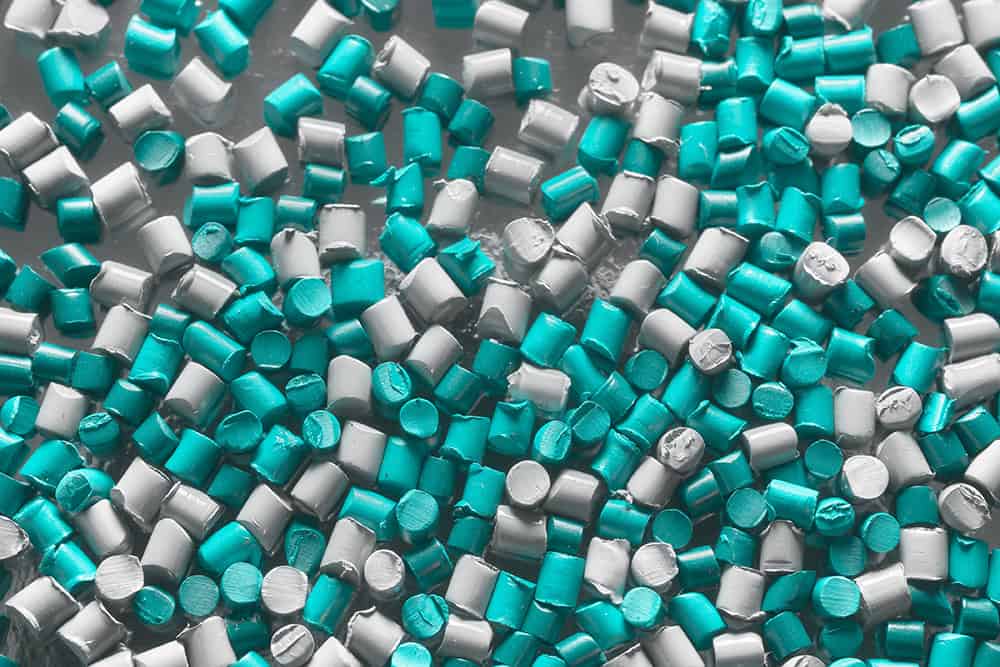
Chemical resistant plastics play a critical role in manufacturing precision parts for applications exposed to harsh chemical environments. Understanding the chemical compatibility of these materials is crucial for selecting the appropriate plastic for specific applications, especially in environments where exposure to various chemicals is inevitable. Applications dealing with chemical exposure, friction, and other harsh factors require plastic parts that withstand tough conditions and resist corrosion.
The chemical resistance of plastics is determined by a particular plastic’s chemical formula. Different polymers have unique molecular structures and chemical compositions that dictate their interactions with various chemicals. This makes material selection a complex but essential process. While some plastics can withstand strong acids with negligible effects on their mechanical properties, others will decompose or dissolve in a short period of time. Furthermore, factors influencing chemical compatibility include molecular structure (cross-linking and crystallinity), functional groups, polymer backbone, and polarity. Due to their high degree of durability, corrosion-resistant materials often require advanced machining knowledge, therefore selecting the right plastic material for manufacturing precision parts is a critical decision that can impact both the cost and performance of a project.
This comprehensive guide examines high-performance polymers with exceptional chemical resistance properties, helping engineers and procurement specialists make informed material selections for precision machined components in demanding applications.
Understanding Chemical Resistance in High-Performance Polymers
Polymer structure at the molecular level fundamentally determines how materials interact with chemicals. Understanding these interactions helps engineers select appropriate materials for harsh chemical environments.
Polymer Morphology: Crystalline vs Amorphous Structures
The morphology of polymers—specifically whether they are amorphous or crystalline—significantly influences their chemical resistance properties. Amorphous polymers possess randomly ordered molecular structures with no long-range order, comparable to tangled spaghetti noodles with complex folding and chain entanglement. In contrast, crystalline polymers form orderly stacks of folded chains known as lamellae, creating a more organized molecular arrangement.
Most crystalline polymers contain amorphous regions, making them semi-crystalline with crystallinity ranging from 0% (entirely amorphous) to 100% (entirely crystalline). This distinction affects how polymers respond to temperature changes. Crystalline polymers have traditional melting points (Tm), while amorphous polymers have glass transition temperatures (Tg) representing a range where materials transition between glassy and rubbery states.
Notably, semi-crystalline polymers typically offer superior chemical resistance compared to their amorphous counterparts. The highly organized molecular structure of crystalline regions creates a barrier that makes chemical penetration more difficult.
Absorption, Adsorption, and Polymer Degradation
Chemical interactions with polymers occur through two primary mechanisms: absorption, where chemicals enter the plastic, and adsorption, where chemicals adhere to the surface. These interactions can lead to polymer degradation—changes in properties such as tensile strength, color, shape, and molecular weight.
Polymer degradation manifests through:
- Physical effects: swelling, softening, and dimensional changes
- Chemical effects: breaking of polymer chains and reduction in molecular weight
Several factors influence degradation rates, including temperature, chemical concentration, exposure duration, and mechanical stress. Higher temperatures and concentrations generally accelerate degradation processes.
Chemical Resistance vs Corrosion Resistance: Key Differences
Chemical resistance refers specifically to a material’s ability to endure chemical attack for a defined period without significant deterioration of its performance properties. Chemical compatibility affects polymers primarily through swelling, softening, and potential chain breakage.
Corrosion resistance, although sometimes used interchangeably, traditionally describes metals’ ability to resist oxidative degradation. For polymers, chemical resistance encompasses broader resistance to various chemical interactions beyond oxidation.
Semi-crystalline polymers generally demonstrate better chemical resistance than amorphous polymers due to their molecular structure. Additionally, polymer characteristics including bond types, degree of crystallinity, and branching significantly impact resistance properties.
Material Science Behind Chemical Resistance
The molecular architecture of polymers directly influences their resistance to chemical attack. At the microscopic level, several key factors determine how effectively a plastic material can withstand exposure to aggressive substances.
Cross-linking and Chain Entanglement Effects
Cross-linking creates robust three-dimensional networks that significantly enhance chemical resistance by restricting polymer chain mobility. These covalent bonds between polymer chains act as barriers, preventing the diffusion of solvents and chemicals into the polymer matrix. Consequently, crosslinked polymers exhibit reduced swelling in solvents since their dense network structure limits solvent penetration.
The relationship between cross-linking and entanglement is synergistic. Research demonstrates that balancing chemical cross-linking with physical entanglement produces tough, crack-resistant materials. However, excess chemical cross-linking without sufficient polymer entanglements substantially decreases toughness in both isotropic and hybrid gels.
Role of Functional Groups in Polymer Reactivity
Functional groups fundamentally determine how polymers interact with chemicals. Polar functional groups, such as hydroxyl and carboxyl, improve solubility in polar solvents, whereas non-polar groups enhance solubility in non-polar solvents. These reactive sites can essentially determine a polymer’s entire chemical resistance profile.
Specific functional groups create distinct properties:
- Carboxyl groups: Increase acidity, establish cross-linking bonding connections
- Amino groups: Produce basic properties and positive ion characteristics in biological solutions
- Thiol groups: Form disulfide bonds and bind strongly to metals
Polarity Matching: Polar vs Non-Polar Chemical Interactions
Polarity results from uneven partial charge distribution between atoms in a compound. A fundamental principle in chemistry states that “like dissolves like” – polar molecules dissolve polar molecules, and non-polar molecules dissolve non-polar molecules. Indeed, a mixture of polar and non-polar molecules will remain separate (immiscible) unless special molecules with qualities of both are present.
Electronegativity differences determine bond polarity. Bonds between atoms with electronegativity differences greater than 0.4 are considered polar. For instance, water’s bond between hydrogen and oxygen is classified as polar since it has an electronegativity difference of 1.4.
Thermal Stability and Creep Resistance in Harsh Environments
Thermal stability directly affects chemical resistance, primarily since elevated temperatures accelerate chemical reactions and degradation processes. Creep resistance—a material’s ability to resist gradual deformation under constant stress—becomes particularly crucial in chemical environments, since mechanical stress can weaken plastics and make them more susceptible to chemical attack.
For high-performance polymers like PEEK, outstanding creep resistance makes it suitable for applications in harsh chemical environments, particularly at elevated temperatures. PEEK maintains stiffness at high temperatures and is suitable for continuous use up to 170°C (338°F).
Top 7 Chemical Resistant Plastics for Precision Parts
Selecting the optimal material for chemically aggressive environments requires understanding each polymer’s unique performance characteristics. Here’s a breakdown of the top performers for precision machined components:
PEEK: High Strength and Broad Chemical Compatibility
PEEK stands as a premier semi-crystalline thermoplastic with remarkable chemical resistance across a broad spectrum. This linear aromatic polymer maintains its exceptional mechanical properties at temperatures up to 170°C (338°F). It resists most acids, bases, hydrocarbons, and organic solvents while exhibiting minimal swelling. Notably, PEEK shows excellent resistance to hydrochloric acid and phosphoric acid but demonstrates vulnerability to concentrated sulfuric and nitric acids.
PTFE (Teflon): Near-Universal Chemical Inertness
PTFE offers unmatched chemical inertness with temperature resistance from -200°C to 260°C (-328°F to 500°F). This fluoropolymer remains non-reactive to virtually all chemicals due to the strength of carbon-fluorine bonds. Oil and gas refineries, aerospace, and semiconductor industries rely on PTFE for its exceptional resistance to hydraulic fluids, solvents, and cleaning solutions.
PPS: High Resistance to Acids and Solvents
Polyphenylene sulfide (PPS) demonstrates superior performance in acidic conditions compared to many alternatives. Tests in 85% sulfuric acid at 120°C for up to 5000 hours confirmed PPS outperforms even PTFE and PVDF in extreme acidic environments. Approximately 50% of PPS production serves automotive components, including brake, coolant, fuel systems, and powertrain applications.
PVDF (Kynar): UV and Oxidizer Resistant Polymer
Kynar PVDF exhibits excellent chemical resistance to ozone exposure and maintains stability under UV radiation. With a tensile strength of 35-55 MPa (5,000-8,000 psi), this semi-crystalline thermoplastic operates effectively from -20°C to +130°C. PVDF resists most mineral acids, including hydrofluoric acid, but remains vulnerable to esters, ketones, and strongly basic solutions.
Vespel® (PAI): Dimensional Stability at High Temperatures
Vespel® polyimide offers exceptional thermal stability with a glass transition temperature exceeding 400°C (752°F). Its dimensional stability comes from a low, consistent thermal expansion coefficient. For aerospace applications, Vespel® SCP-5050 exhibits thermal oxidative stability and wear resistance at elevated temperatures, making it ideal for replacing metal components.
UHMW: Low-Cost Option with Broad Chemical Resistance
Ultra-High Molecular Weight Polyethylene provides cost-effective chemical resistance. Its unique crystalline structure resists most acids, bases, and solvents without swelling or degradation. UHMW meets FDA, USDA, and 3-A Dairy guidelines, making it ideal for food processing applications.
ECTFE (Halar): Resistance to Sulfuric Acid and Radiation
Halar ECTFE demonstrates excellent resistance to strong acids, including sulfuric, nitric, hydrochloric, and hydrofluoric acids over wide temperature ranges. Moreover, it offers the best radiation resistance among fluoropolymers and maintains stability against oxidizers and bleaching agents. Its extremely low extractables make Halar ideal for semiconductor, biotech, and pharmaceutical ultra-pure applications.
Application-Specific Material Selection Guidelines
Effective selection of chemical resistant plastics requires analyzing specific application environments. Each industry presents unique challenges that determine optimal material choices.
Medical Devices: Biocompatibility and Sterilization Resistance
Medical-grade plastics must demonstrate exceptional biocompatibility while withstanding repeated sterilization cycles. Accordingly, materials must prevent adverse reactions such as toxicity, irritation, or inflammation when contacting human tissue or fluids. PEEK stands out for its biocompatibility and ability to maintain properties through multiple sterilization methods. PEI (Ultem®) offers excellent heat resistance and dimensional stability, making it ideal for surgical instruments and sterilization trays. Initially, materials should undergo rigorous testing including cytotoxicity, sensitization, and hemocompatibility evaluations.
Semiconductor Components: Low Outgassing and Purity
Semiconductor manufacturing demands materials with minimal contamination potential. High purity plastics like PEEK and PFA feature low levels of leachables and extractables along with minimal outgassing characteristics. Key material requirements include:
- Electrostatic control properties
- Low particle generation in bearing applications
- Minimal extractables when exposed to high-purity chemicals
- High temperature capabilities
- Dimensional stability
FM4910 qualified materials are often specified for critical semiconductor applications where flame retardancy must complement chemical resistance.
Chemical Processing: Resistance to Acids, Bases, and Solvents
Chemical processing environments expose materials to hydrochloric acid, sulfuric acid, chromic acid, and hydrofluoric acid. Correspondingly, material selection must consider continuous operating temperature, mechanical loads, and electrical conductivity requirements. PTFE remains virtually inert to all chemicals except rare compounds like oxygen difluoride. For chemical tanks and piping systems, PVC offers cost-effective chemical resistance with excellent joining capabilities.
Aerospace: Weight, Strength, and Environmental Exposure
Aerospace applications benefit from high-performance plastics that reduce weight by up to 50% compared to metal parts. Hence, these materials significantly improve fuel efficiency while reducing maintenance requirements by approximately 20%. PEEK maintains its exceptional properties at temperatures up to 260°C (500°F), withstanding aviation fuels and hydraulic fluids without degradation.
CNC Machining Considerations for Chemically Resistant Plastics
CNC machining of chemical-resistant plastics requires specialized knowledge due to their unique properties. Material selection must account for dimensional stability, machinability, and post-processing requirements. Primarily, engineers should evaluate corrosion resistance alongside mechanical properties to ensure optimal performance in the intended chemical environment.
Conclusion
Chemical resistance properties stand as crucial determinants of plastic performance in demanding environments. This comprehensive examination demonstrates how polymer structure at the molecular level—from crystallinity to cross-linking—fundamentally shapes material behavior when exposed to aggressive chemicals. Semi-crystalline polymers generally outperform their amorphous counterparts due to their organized molecular structure creating effective barriers against chemical penetration.
Understanding the science behind chemical resistance allows engineers to make informed decisions when selecting materials. Factors such as functional groups, polarity matching, and thermal stability work together to determine how effectively a polymer withstands specific chemical exposures. This knowledge becomes particularly valuable when designing precision components for critical applications across medical, semiconductor, chemical processing, and aerospace industries.
The seven highlighted high-performance polymers—PEEK, PTFE, PPS, PVDF, Vespel, UHMW, and ECTFE—each offer unique combinations of chemical resistance properties suited to different application requirements. PEEK delivers exceptional strength and broad chemical compatibility, while PTFE provides nearly universal chemical inertness. PPS excels in acidic environments, and PVDF offers superior resistance to oxidizers and UV radiation.
Material selection ultimately depends on specific application parameters. Medical devices require biocompatibility alongside sterilization resistance, whereas semiconductor components demand ultra-high purity and minimal outgassing. Chemical processing environments necessitate resistance to specific acids, bases, and solvents under varying temperature conditions. Speak with an AIP engineer to identify the optimal chemical-resistant polymer for your application.
Proper material selection significantly impacts both the performance and longevity of precision machined components exposed to harsh chemical environments. The right polymer choice can prevent costly failures, reduce maintenance requirements, and extend service life. Engineers must therefore consider not only chemical compatibility but also mechanical properties, dimensional stability, and machinability when specifying materials for critical applications.
This technical understanding of chemical-resistant plastics undoubtedly empowers engineers and procurement specialists to make better-informed decisions. Through careful analysis of polymer characteristics and application requirements, manufacturers can confidently select materials that deliver reliable performance even under the most demanding chemical exposure conditions.
FAQs
Q1. What are the top chemical-resistant plastics for precision parts?
The top chemical-resistant plastics for precision parts include PEEK, PTFE (Teflon), PPS, PVDF (Kynar), Vespel (PAI), UHMW, and ECTFE (Halar). Each offers unique properties suitable for different applications and chemical environments.
Q2. How does polymer structure affect chemical resistance?
Polymer structure, particularly crystallinity, significantly influences chemical resistance. Semi-crystalline polymers typically offer superior chemical resistance compared to amorphous ones due to their more organized molecular structure, which creates a barrier against chemical penetration.
Q3. What factors should be considered when selecting chemical-resistant plastics for specific applications?
When selecting chemical-resistant plastics, consider factors such as the specific chemicals involved, operating temperatures, mechanical loads, dimensional stability, and industry-specific requirements (e.g., biocompatibility for medical devices or purity for semiconductor components).
Q4. How does PEEK compare to other chemical-resistant plastics?
PEEK offers high strength and broad chemical compatibility, maintaining its exceptional properties at temperatures up to 170°C (338°F). It resists most acids, bases, hydrocarbons, and organic solvents, making it suitable for various demanding applications across industries.
Q5. What are the key differences between chemical resistance and corrosion resistance in plastics?
Chemical resistance refers to a material’s ability to withstand chemical attack without significant deterioration of its performance properties, primarily affecting polymers through swelling, softening, and potential chain breakage. Corrosion resistance traditionally describes metals’ ability to resist oxidative degradation, but for polymers, it encompasses broader resistance to various chemical interactions beyond oxidation.






